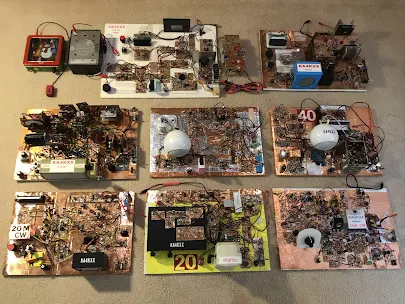I
tried a Si5351 VFO once in the dual-band rig #4, but by the time I built the
QRP Labs kit with so much closely-spaced soldering, and then added
sufficient filtering and amplification to properly drive a 50 ohm load, I
was exhausted!
These nine were created during the past eight years, and
were preceded by eight more transceivers that I can document, but those have
all been disassembled, with many of the parts being used in these later
rigs. I build my transceivers to be
operated often, and since 20 Meters has been hot lately, for example, my POTA
Hunter log shows over 300 CW and SSB contacts in 2023 alone, so rig numbers 7 -
9 have been earning their keep lately.
In summary I have created a lifetime total of seventeen transceivers so far, and although I am nowhere near the fifty-plus tally of Pete N6QW, I did spend a lot of years instead homebrewing many radio-controlled model airplanes of my own design. Two photos show one example that I flew in the 2011 Blue Max Scale R/C Contest at the Fantasy of Flight Museum in Polk City, Florida against some stiff QRO competition.
—Walter KA4KXX




When I saw those model planes I thought of Ross A. Hull. I first read about him in an Electronics Australia magazine that I still have. He wrote this:
ReplyDelete“Most hams are usually far from being one-hobby men and one discovers, almost invariably, an interest in the other sciences and the crafts. A common interest in ham radio, aeronautics, model building, and photography is almost the rule. We happen to be built that way and our interest in aircraft led us, this summer, to take an active interest in this problem of radio control.”
His career:
1902 – Born in Melbourne, Australia
1921 - Although he was trained to be an architect, early in his life he developed a great interest for [[Radio|radio], Amateur Radio in particular.
1922 – Noted as first Australian radio operator to hear American radio signals
1924 – Became Federal Vice President of the Wireless Institute of Australia
1926 – As Secretary to the Wireless Institute of Australia, Hull visited the American Radio Relay League (ARRL) headquarters in Connecticut to study American radio activity; filled a vacancy in technical information service in the editorial department
1928 – Director of a special technical development program at the ARRL
1929 – Returned to Australia to become technical editor of Wireless Weekly
1931 – Returned to America to become Associate Editor of QST magazine; continued developing new radio equipment at the ARRL headquarters laboratory
1934 – Demonstrated for the first time that a five-meter amateur radio station could receive signals over 100 miles, considered at the time to be a revolutionary development in amateur radio
1935 – Developed a device for correlating signal strength with other data, and this led to his discovery that VHF signals are refracted in the lower atmosphere in a manner similar to light rays, a major scientific discovery
1937 – Invented the escapement, a device that used rubber bands to control the surfaces of model airplanes
1937 – Designed and built a series of radio-controlled model sailplanes, making over 100 flights in the summer and fall
1938 – Flew radio-controlled model sailplane Skyrider on July 1 at the National Soaring Contest held at Elmira, New York with the help of Bourne (W1ANA), with Bourne acting as control operator. The Skyrider used an improved, though bulkier and heavier, method of control employing continuously reversible small D.C. motors; also experimented with radio gear in manned gliders to allow the contest crowd to hear pilot chatter from the ground, following the example of Grant Meeker (W8ADV) who conducted similar installations at the 1937 National Soaring Contest
1938 – Died as the result of an accidental electrocution at his home in Vernon, Connecticut on September 13.
I feel very justified in spending a lot of time build foamies and browsing RC Groups
ReplyDeleteRoss Hull never had a ham license while in the US
ReplyDeleteI think we are looking at QRP and QRO model airplanes in that picture ;)
ReplyDeleteThose two rigs with the ball-shaped speakers are really cool. I'd love to see more and closer photos of these.
ReplyDeleteTodd K7TFC, I just emailed you two photos.
ReplyDeleteI always try to use good quality heavy magnet speakers in my rigs, but about 15 years ago I bought this pair of high-end Orb Audio hi-fi speakers for a homebrew portable boombox to use with my new iPod. Then recently I decided to re-purpose them into these radios. When I bought them they were probably about $80 for the pair, but current price is $300, so probably better speakers than most hams have!
Thanks for the pics, Walter. In addition to the speakers, In addition to the speakers, I really like the billboard-sized "40M"--proudly singled-banded.
ReplyDelete